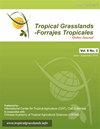主成分分析法在牧草产量及营养特性研究中的应用
IF 0.7
4区 农林科学
Q3 AGRICULTURE, DAIRY & ANIMAL SCIENCE
引用次数: 1
摘要
本研究的目的是利用主成分分析(PCA)评估各种产量和营养特征对饲草品种分化的重要性。数据来自用6次重复的完全随机区组设计(RCBD)进行的实验。对11个饲草品种进行了评价,这些品种分别为:乌罗奇洛阿(Urochloa brizantha)、鲁济济慈(U.ruziziensis。在产量特征方面,主成分分析表明,前三个成分解释了82.0%的牧草品种间总变异。在营养特性方面也观察到了类似的结果,前3种成分解释了91.4%的叶化学成分总变异和83.8%的茎化学成分变异。对饲料品种之间的差异贡献最大的变量是:单株分蘖数;单株叶数;中位叶宽;茎干物质产量;叶茎比;%叶片干物质、粗蛋白(CP)%和中性洗涤纤维%;以及茎的%CP、%乙醚提取物和%酸性洗涤纤维。主成分分析有效地确定了在评估草种时需要测量的关键参数,并减少了在评估牧草品种的实验中需要评估的产量和营养特征的数量。这既减少了工作量,又降低了所涉费用,同时仍能得出有效的结论。本文章由计算机程序翻译,如有差异,请以英文原文为准。
Principal component analysis applied to the study of yield and nutritional characteristics of forage cultivars
The objective of this study was to evaluate the importance of various yield and nutritional characteristics for the differentiation of forage cultivars using principal component analysis (PCA). Data were obtained from an experiment conducted with a complete randomized block design (RCBD) with 6 replications. Eleven cultivars of forage grasses of the species Urochloa brizantha, U. ruziziensis, Megathyrsus maximus, Cenchrus ciliaris, Andropogon gayanus and Setaria sphacelata were evaluated. For yield characteristics, PCA revealed that the first 3 components explained 82.0% of total variation between forage cultivars. Similar results were observed for nutritional characteristics with the first 3 components explaining 91.4% of total variation in leaf chemical composition and 83.8% of variation in stem chemical composition. Variables that contributed most to discrimination between forage cultivars were: number of tillers per plant; number of leaves per plant; median leaf width; stem dry matter yield; leaf:stem ratio; % dry matter, % crude protein (CP) and % neutral detergent fiber of leaves; and % CP, % ether extract and % acid detergent fiber of stems. PCA was effective in identifying the key parameters that need to be measured in evaluating grass species and allowed a reduction in the number of yield and nutritional characteristics to be assessed in experiments designed to evaluate forage cultivars. This reduced both the workload and the costs involved while still allowing valid conclusions.
求助全文
通过发布文献求助,成功后即可免费获取论文全文。
去求助
来源期刊

Tropical Grasslands-Forrajes Tropicales
Agricultural and Biological Sciences-Agronomy and Crop Science
CiteScore
1.60
自引率
0.00%
发文量
36
审稿时长
16 weeks
期刊介绍:
The Journal publishes, in English or Spanish, Research Papers and Short Communications on research and development, as well as contributions from practitioners (Farmer Contributions) and Review Articles, related to pastures and forages in the tropics and subtropics. There is no regional focus; the information published should be of interest to a wide readership, encomprising researchers, academics, students, technicians, development workers and farmers.
In general, the focus of the Journal is more on sown (''improved'') pastures and forages than on rangeland-specific aspects of natural grasslands, but exceptions are possible (e.g. when a submission is relevant for a particularly broad readership in the pasture and forage science community).
The Journal will also consider the occasional publication of associated, but closely related, research in the form of an additional scientific communication platform [e.g. a re-make of the former Genetic Resources Communication series of the former Division of Tropical Crops and Pastures of the Commonwealth Scientific and Industrial Research Organisation (CSIRO), Australia].
Areas of particular interest to the Journal are:
Forage Genetic Resources and Livestock Production[...]
Environmental Functions of Forages[...]
Socio-economic Aspects[...]
Topics within the aforementioned areas may include: Diversity evaluation; Agronomy; Establishment (including fertilization); Management and utilization; Animal production; Nutritive value; Biotic stresses (pests and diseases, weeds); Abiotic stresses (soil fertility, water, temperature); Genetics and breeding; Biogeography and germplasm collections; Seed production; Ecology; Physiology; Rhizobiology (including BNF, BNI, mycorrhizae); Forage conservation; Economics; Multilocational experimentation; Modelling.
 求助内容:
求助内容: 应助结果提醒方式:
应助结果提醒方式:


